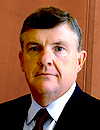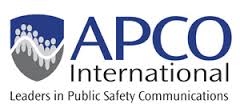High Accountability + High Reward = High Retention
APCO International’s Derek Poarch shares his thoughts about motivating employees and guiding a diverse membership through a sea change of technology changes.

We caught up with Derek Poarch, executive director of APCO International, the world’s oldest and largest organization for public safety communications professionals, just days after the tragic shootings in San Bernardino, California. A longtime fixture in the law enforcement and public safety arena, Poarch guides the nearly-26,000 member association with a mix of compassion, staff autonomy and tough accountability.
Association Adviser: Derek, tell us a little about APCO.
Derek Poarch: We’ve been around since 1935. We have 25,797 members who are primarily the call takers, dispatchers, supervisors and directors that run the 911 call centers around the country. As the world’s largest organization for public safety communication specialists, we’re one of only four licensed public safety spectrum coordinators in the country. Any time there’s a new frequency assigned to police, fire or EMS around the country, we’re one of only four groups that has the authority to oversee that.
AA: How else are you helping members?
DP: We’ve been very successful at helping public safety professionals in times of need. We have the APCO Sunshine Fund to provide financial assistance to public safety professionals and immediate family who are facing traumatic loss or death or illness. Here in the D.C. office, we do advocacy on Capitol Hill and with the Federal Communication Commission, regarding rules and laws that affect our members. We’re doing everything we can to support our members and to further our profession.
Derek Poarch is not your typical association executive director. ![]()
APCO International’s membership has grown by 60 percent since 2012. ![]()
Group memberships and strong volunteer engagement have driven APCO’s growth. ![]()
Hire good people. Train, support and reward them. Make sure they know what they’re accountable for as it relates to your strategic plan. ![]()
AA: Have you been able to sustain membership during this era of dramatic demographic and technological change?
DP: Actually, our membership has grown by 60 percent since 2012. The group membership [option], which allows agencies to enroll their entire departments and all of their staff, has added significantly to our growth. Also, we’re very diligent about making sure that EVERY member who wants to work on committees can be involved at APCO and find the right fit for their skills.
AA: How does APCO differ from other public safety organizations?
 DP: We’re nationwide, not local, and we have an international presence, especially Canada, Great Britain and Australasia. Also, we’re multidisciplinary across 911, police, fire and EMS. In addition to that, we’re highly-technologically focused. Technology is changing at a record pace throughout the industry, so we offer many opportunities for our members to keep current with the technologies that are facing them — everything from next-generation 911 to cybersecurity. The APCO Institute at our Daytona Beach, Florida, headquarters trains over 16,000 people a year, both in-person and online.
DP: We’re nationwide, not local, and we have an international presence, especially Canada, Great Britain and Australasia. Also, we’re multidisciplinary across 911, police, fire and EMS. In addition to that, we’re highly-technologically focused. Technology is changing at a record pace throughout the industry, so we offer many opportunities for our members to keep current with the technologies that are facing them — everything from next-generation 911 to cybersecurity. The APCO Institute at our Daytona Beach, Florida, headquarters trains over 16,000 people a year, both in-person and online.
AA: Speaking of technology, 9/11 was a watershed event for APCO and the public safety profession. How has public safety communication technology evolved since that terrible tragedy of 2001?
DP: Since 9/11, there’s been a huge recognition that public safety and first responders have to have the need to communicate. That was one of the flaws in [the system] on 9/11 that we’ve worked hard to fix. The First Responder Network Authority [FirstNet] has come into play and been authorized and funded by Congress and the President. And now for the first time, we have spectrum assigned on a nationwide basis for interoperability. That’s been a huge change [for the better] since 9/11. As this network is built out, first responders will have the opportunity to receive information in real time, whether it’s in the form of data, video or voice. Also, as we move to different types of systems, apps are starting to be developed for public safety. We’re also leading in that area to make sure apps for public safety and emergency response are as safe and effective as possible, including the launch of an online app resource called AppComm, where new apps can be easily loaded and vetted and commented upon.
AA: Speaking of tech, we understand you just had another semiannual Emerging Technology Forum in Atlanta.
DP: That’s right. These forums are two-day events held all around the country that typically draw 175 to 200 people who can’t come to our annual conference. We talk about next-gen technologies and what it’s going to mean to be a telecommunicator in the public safety answering point [PSAP] of the future. For instance, how will you be able to take the videos and pictures sent in from the public and push them out to the field? We also talk about cybersecurity and ways to protect PSAPs.
AA: Can you talk about mobile and other APCO initiatives for reaching on-the-go members?
DP: Many people may not realize that when our members are on duty as dispatchers, they are not allowed to have their smart devices in the highly-secure dispatch centers. That’s why it’s very important for us to have a print presence so our members can continue to get the magazine [Public Safety Communications], to see what’s going on and share it while they’re in the center.
At the same time, we recognize that our membership is getting younger and they’re accustomed to receiving information on smart devices, and we have to adapt to that. So, our magazine also goes out online, so they can read it on their smartphones away from work. We also have a Facebook presence and a Twitter presence. When we’re doing events, our government relations team sends out frequent real-time tweets to our members so they can follow what’s going on.
AA: How long have you been at APCO? Do you have a background in public safety/security?
DP: I came to APCO as executive director in November 2011. Prior to that, I spent 30 years in law enforcement, including 10 years as chief of police at University of North Carolina. I was also the public safety and homeland security bureau chief at the Federal Communications Commission. As my career winds down, I guess you could say I’ve come full circle. I started out as a dispatcher when I was 18 and right out of high school. Now, here I am again 40 years later.
AA: What are the biggest challenges faced by APCO members today, and how is APCO helping to address them?
DP: Technology first, then staffing and funding. Our members are mostly government employees. Budgets are tight. Most are still working on systems designed to receive emergency calls via telephone, and they must still send information out to the field by phone. As next-gen technologies continue to emerge, data, pictures and videos are received in the centers and sent out to the field. The technology is there, but we need the funding. Processing video, text and pictures that come in is not the same as processing phone calls.
AA: What would you say are APCO’s most important member communication vehicles?
DP: Public Safety Communications (24,000 circulation), is our flagship magazine. Our website [www.apcointl.org] is also key, as well as the weekly PSC eNews (50,000 distribution), which highlights industry events, trends and law changes. Also, our live events are very important. Our annual conference draws over 5,000 people. In addition to high profile speakers, we offer a tremendous amount of classroom training and professional development tracks. As I mentioned earlier, we hold two emerging technology conferences every year, plus a summit focused exclusively on broadband. Naylor has been very helpful in getting accurate, timely information out to our members via our publications and website.
AA: How about APCO’s social media initiatives?
DP: In addition to Facebook and Twitter, we have PS Connect. It’s an unmoderated public forum that allows APCO to communicate with members, and for members to communicate with each other. It’s been very helpful for members who have questions about a certain law, or questions about new technologies they’re considering acquiring for their centers.
AA: Derek, how would you describe your leadership style?
DP: I’m not your typical association executive director, as I’ve only spent a few years running an association. That said, my style is very democratic. We use a group environment to set goals. I also believe in hiring the best people and giving them the best equipment and training that we can so we utilize their knowledge and skills. I also believe strongly in high performance and doing things better and faster.
AA: How do you accomplish that?
DP: We’re very committed to strategic planning, goals and measures. We use the balanced scorecard system for setting goals within each department. The goals and measures are monitored EACH month at our headquarters. Then we take it a step further. The organization’s goals and measures are tied to every employees’ work plan. We have a performance-based pay system, which I brought in from my previous life as a police chief. The way you focus employees, accomplish goals and achieve 60 percent membership growth is by having all 57 employees understand what’s really important for the organization and what’s not. Everyone has a financial goal to meet, an improvement goal to meet, and a customer goal to meet. I suspect that’s different from what a lot of associations do.
AA: What do you like most about working in the association world?
DP: One of the nice things about having a performance-based, balanced scorecard approach is that you don’t have to have a ‘command and control’ style of leadership like you do in law enforcement. Fortunately I have wonderful, dedicated people who really understand their jobs here. They know what’s important, and we reward them well. We also have very supportive volunteer leaders who have great confidence in our staff. I get to be an executive director most of the time and rarely have to be a chief of police. [chuckling]
AA: Do have any special strategies for connecting with millennial staffers and young members of the profession?
DP: No. I don’t communicate with millennials any differently than I communicate with someone who’s been here for 25 years. We hire quality people of all ages and train them well. I believe that people really want to do a good job, and we want to reward them well. I know what it’s like in government where someone else can get the same raise as you even if they don’t work as hard. That’s not how it works at APCO. It starts with the strategic plan. Every person, regardless of age, has measurable goals and objectives tied to that plan. It may sound tough, but we have very low turnover here. Everyone is empowered to suggest ideas. We’re a compassionate family here and we care about each other.
AA: What’s keeping you up at night (work-related)?
DP: In a prior life, I was a chief of police. Nothing work-related keeps me up at night now. [chuckling]

